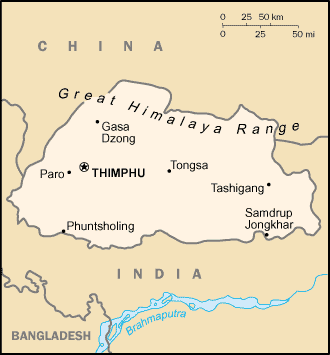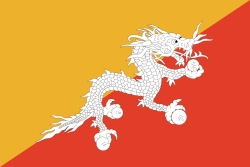Bhutan
Related Categories:
 National Symbols of Bhutan
National Symbols of BhutanNational flag, national flower, national bird, national tree etc.
www.windhorsetours.com/
The national emblem is contained in a circle with two dragons framing a double diamond - thunderbolt (dorji) placed above a lotus, surmounted by a jewel.
www.discoverbhutan.biz/
Many eastern classics and books of wisdom have referred to the Himalayas as the abode of the gods and home to the immortals.
www.asia-planet.net/
Bhutan is a Buddhist state where power is shared by the king and government. The country's name in the local dialect means Land of the Dragon.
www.fotw.us/
Stone tools, weapons, and remnants of large stone structures provide evidence that Bhutan was inhabited as early as 2000 BCE.
en.wikipedia.org/
The people of Bhutan can be divided into three broad ethnic categories--Ngalops, Sharchops, and Lhotsampas. The Ngalops make up the majority of the population, living mostly in the western and central areas. The Ngalops are thought to be of Tibetan origin, arriving in Bhutan during the 8th and 9th centuries A.D. and bringing Buddhism with them. Most Ngalops follow the Drukpa Kagyupa discipline of Mahayana Buddhism. In a country that is deeply rooted within the Buddhist religion, many people's sect of religion, as opposed to their ethnic group, characterizes them. The Ngalops predominate in the government, and the civil service and their cultural norms have been declared by the monarchy to be the standard for all citizens.
The Sharchops, who live in the eastern section of Bhutan, are considered to be descendants of the earliest major group to inhabit Bhutan. Most follow the Ningmapa discipline of Mahayana Buddhism. Sharchop is translated as "people of the east." The Ngalops, Sharchops, and the indigenous tribal people are collectively known as Drukpas and account for about 65% of the population. The national language is Dzongka, but English is the language of instruction in schools and an official working language for the government.
The Lhotsampas are people of Nepali descent, currently making up 35% of the population. They came to Bhutan in the 19th and 20th centuries, mostly settling in the southern foothills to work as farmers. They speak a variety of Nepali dialects and are predominantly Hindu.
www.state.gov/r/
Introduction
About
Contact
Symbols in The News
Interpret this Symbol
AAC
African
AI
Alchemy
Alphabets
Ancient
Animal Symbolism
Architecture
Art
Articles
Astrology
Baha'i
Blissymbolics
Blueprint Symbols
Buddhist
Celtic Symbols
Cemetery
Chinese Symbols
Christian
Circle
City
Codes
Color
Conlangs
Crop Circles
Danger
Da Vinci Code
Designing Logos
Dictionaries
Dreams
Education
Egyptian Symbols
Electrical
Emoticons
Find Images
Fonts
Food
Fraternity
Hamsa
Healing
Heraldry
Hermetic
Highway Signs
Hindu
History
Hobo
Holiday
Icons
iConji
Islamic
Jain Symbols
Japanese, Kanji
Jewish
Justice
Law
Literary Symbolism
Mandalas
Map
Masonic
Math, Number
Meaning of Names
Medical
Middle East
Military
Miscellaneous
Money
Music
Mythology
Native American
Playing Cards
Power
Psychology
QiQiiKhu
Reiki
Religious
Runes, Norse
Sacred Geometry
Scientific
Science Fiction
Sorority
Sports
Symbols in the News
Tattoos
ThirteenSymbols
Tree of Life
Ursprache
Videos
Visual Languages
Weather
Web Codes
Wicca
Words
Writing Systems
Braille
Coinherence
Coptic
Cuneiform
Easter Island
Etruscan
Happy Human
Hebrew
Kokopelli
Linear B
Lotus
Love Symbols
Mandorla
Moon Alphabet
Nine Pointed Star
Om
Oz
Phonetic
Scarab Beetle
Silent
Theosophy
Unifon
About
Contact
Symbols in The News
Interpret this Symbol
AAC
African
AI
Alchemy
Alphabets
Ancient
Animal Symbolism
Architecture
Art
Articles
Astrology
Baha'i
Blissymbolics
Blueprint Symbols
Buddhist
Celtic Symbols
Cemetery
Chinese Symbols
Christian
Circle
City
Codes
Color
Conlangs
Crop Circles
Danger
Da Vinci Code
Designing Logos
Dictionaries
Dreams
Education
Egyptian Symbols
Electrical
Emoticons
Find Images
Fonts
Food
Fraternity
Hamsa
Healing
Heraldry
Hermetic
Highway Signs
Hindu
History
Hobo
Holiday
Icons
iConji
Islamic
Jain Symbols
Japanese, Kanji
Jewish
Justice
Law
Literary Symbolism
Mandalas
Map
Masonic
Math, Number
Meaning of Names
Medical
Middle East
Military
Miscellaneous
Money
Music
Mythology
Native American
Playing Cards
Power
Psychology
QiQiiKhu
Reiki
Religious
Runes, Norse
Sacred Geometry
Scientific
Science Fiction
Sorority
Sports
Symbols in the News
Tattoos
ThirteenSymbols
Tree of Life
Ursprache
Videos
Visual Languages
Weather
Web Codes
Wicca
Words
Writing Systems
Braille
Coinherence
Coptic
Cuneiform
Easter Island
Etruscan
Happy Human
Hebrew
Kokopelli
Linear B
Lotus
Love Symbols
Mandorla
Moon Alphabet
Nine Pointed Star
Om
Oz
Phonetic
Scarab Beetle
Silent
Theosophy
Unifon

